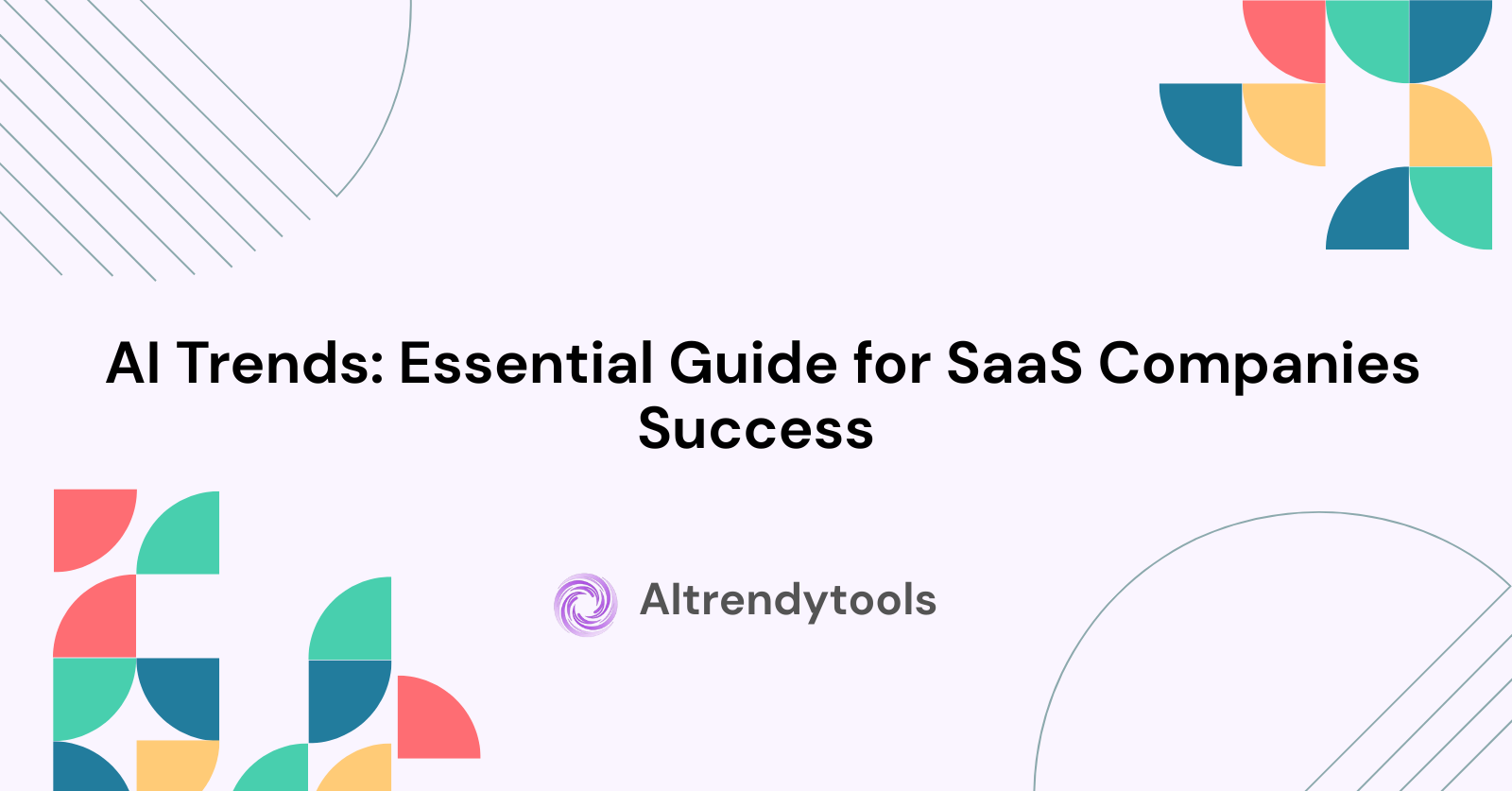🔥 AITrendytools: The Fastest-Growing AI Platform |
Write for usAI Trends: Essential Guide for SaaS Companies Success
Discover critical AI trends for 2026 that SaaS companies must watch. Learn about agentic AI, predictive analytics, and data-driven insights.
Sep 10, 2025
The State of AI in 2026: Emerging Trends SaaS Companies Must Watch
The artificial intelligence landscape is evolving at breakneck speed, with 2026 poised to be a pivotal year for SaaS companies. Industry research indicates that over 80% of enterprises will have deployed generative AI applications by 2026, up from less than 5% in 2023. This dramatic shift represents both unprecedented opportunities and significant challenges for software-as-a-service providers.
SaaS companies find themselves at the epicenter of this transformation. They are not just adopting AI internally but embedding intelligence into their product offerings to deliver enhanced value to customers. The convergence of advanced AI capabilities with cloud-based software delivery models is creating entirely new business paradigms and competitive advantages.
The stakes could not be higher. Organizations that successfully harness these emerging trends will capture market leadership, while those that fall behind risk obsolescence. The AI revolution rewards early adopters who can navigate technical complexity while maintaining focus on customer value and business outcomes.
Understanding which trends deserve investment versus which represent mere hype becomes critical for strategic planning. The following analysis examines the most impactful AI developments that will shape SaaS success in 2026 and beyond.
Agentic AI Reshaping SaaS Business Models
Agentic AI represents the most significant paradigm shift in software development since the advent of cloud computing. These autonomous systems can adapt to changing environments, make complex decisions, and collaborate seamlessly with humans and other AI agents.
SaaS companies are discovering that agentic AI transforms their core value propositions. Rather than providing static tools that require constant human operation, they can now offer intelligent agents that work independently to achieve business objectives. This shift moves beyond traditional software automation toward true digital workforce augmentation.
Key Characteristics of Agentic AI Systems:
- Autonomous decision-making: Systems that evaluate situations and take actions without constant human oversight
- Adaptive learning: Agents that improve performance through experience and environmental feedback
- Multi-agent collaboration: Networks of AI systems working together on complex, multi-step processes
- Goal-oriented behavior: Intelligence focused on achieving specific business outcomes rather than executing predefined tasks
- Contextual awareness: Understanding of business rules, constraints, and priorities within specific operational environments
Customer service platforms exemplify this transformation perfectly. Traditional chatbots follow scripted responses, while agentic AI agents understand customer intent, access relevant data across systems, and resolve complex issues end-to-end. They learn from each interaction to improve future performance and can escalate to human agents when appropriate.
Sales automation represents another powerful application area. Agentic AI can research prospects, personalize outreach campaigns, schedule meetings, and even conduct initial qualification conversations. The technology handles routine sales activities while human representatives focus on relationship building and complex deal negotiations.
The business model implications are profound. SaaS companies can charge premium prices for outcomes rather than features. Success metrics shift from user engagement to business results, creating stronger customer relationships and reducing churn through demonstrated value delivery.
Predictive Analytics Transforming Customer Experience
Predictive analytics capabilities in 2026 will fundamentally alter how SaaS companies understand and serve their customers. Advanced machine learning models can now process vast amounts of historical data, real-time behavioral signals, and external market indicators to forecast customer needs with unprecedented accuracy.
The technology enables SaaS platforms to anticipate problems before they occur and deliver proactive solutions. Customer churn prediction models can identify at-risk accounts weeks or months in advance, enabling targeted retention campaigns. Usage pattern analysis reveals optimization opportunities that improve customer outcomes and drive expansion revenue.
Predictive Analytics Applications in SaaS:
- Churn prediction: Identifying customers likely to cancel subscriptions based on usage patterns and engagement metrics
- Expansion forecasting: Predicting which accounts are ready for upselling or cross-selling opportunities
- Performance optimization: Anticipating system bottlenecks and scaling resources before issues impact users
- Feature adoption: Understanding which capabilities will resonate with specific customer segments
- Support ticket prediction: Forecasting support volume and automating resolution for common issues
Financial planning software demonstrates these capabilities in action. Modern platforms analyze spending patterns, cash flow trends, and market conditions to predict future financial needs. They automatically adjust budgets, suggest investment strategies, and alert users to potential cash flow issues before they become critical.
Marketing automation platforms leverage predictive analytics to optimize campaign timing, content selection, and channel preferences for individual prospects. The systems learn from historical response data to improve engagement rates and conversion performance continuously.
The competitive advantage comes from transforming reactive customer service into proactive value delivery. SaaS companies that master predictive analytics can prevent problems, anticipate needs, and deliver solutions before customers even realize they have challenges.
Small Language Models Democratizing AI Access
The industry trend toward smaller, more specialized language models represents a significant opportunity for SaaS companies to integrate AI capabilities without the infrastructure costs and complexity of large foundation models. These compact systems deliver focused functionality while requiring substantially fewer computational resources.
Small language models excel in specific domains where they can be trained on relevant data sets and optimized for particular use cases. A customer service SaaS platform might deploy a small model trained specifically on support ticket data and company knowledge bases, achieving better performance than a general-purpose large model.
Advantages of Small Language Models for SaaS:
- Cost efficiency: Significantly lower training and inference costs compared to large models
- Faster performance: Reduced latency enables real-time applications and better user experiences
- Data privacy: Models can run on-premises or in private clouds, maintaining data security
- Customization flexibility: Easier to fine-tune for specific business requirements and industry verticals
- Deployment simplicity: Lighter resource requirements enable edge computing and mobile applications
Document management platforms showcase this approach effectively. Instead of using massive general-purpose models, they deploy specialized small models trained on business documents, contracts, and industry-specific terminology. These focused systems provide more accurate document classification, extraction, and summarization capabilities.
Project management SaaS tools leverage small models for intelligent task prioritization, resource allocation, and timeline prediction. The models understand project management terminology and methodologies while operating efficiently within the platform's existing infrastructure.
The democratization effect cannot be overstated. Small language models enable even early-stage SaaS companies to integrate sophisticated AI capabilities without requiring massive capital investments or specialized infrastructure teams.
Data-Driven Insights Powering Business Intelligence
The convergence of AI with comprehensive data strategies is creating unprecedented business intelligence capabilities for SaaS platforms. Companies that can collect, integrate, and analyze data across multiple touchpoints gain significant competitive advantages through deeper customer understanding and operational optimization.
Modern SaaS platforms are becoming data orchestration engines that gather information from user interactions, system performance, external market sources, and integration partner APIs. AI systems process this data to generate actionable insights that inform product development, customer success initiatives, and strategic decision-making.
Essential Components of Data-Driven SaaS Intelligence:
- Real-time data integration: Combining information from multiple sources to create comprehensive customer profiles
- Behavioral analytics: Understanding how users interact with features to optimize user experience and identify expansion opportunities
- Performance monitoring: Tracking system health and user satisfaction to prevent issues and improve service delivery
- Market intelligence: Analyzing external trends and competitive dynamics to inform product strategy
- Revenue attribution: Connecting customer actions to business outcomes for accurate ROI measurement
CRM platforms demonstrate the power of this approach through unified customer data models that integrate sales activities, marketing campaigns, support interactions, and product usage. AI systems analyze these comprehensive profiles to recommend next best actions for sales teams and predict customer lifetime value.
Accounting software leverages data integration to provide automated bookkeeping, expense categorization, and financial forecasting. The systems learn from historical patterns while incorporating real-time bank feeds and transaction data to deliver accurate, up-to-date financial insights.
The strategic implication is that data becomes a primary competitive differentiator. SaaS companies with superior data collection and analysis capabilities can deliver more valuable insights, better customer experiences, and more effective business outcomes.
AI-Powered Personalization Enhancing User Engagement
Personalization technology in 2026 will move beyond simple content recommendations toward comprehensive experience customization that adapts to individual user preferences, working styles, and business objectives. AI systems will understand user context, goals, and constraints to deliver truly personalized software experiences.
The sophistication extends to interface adaptation, feature prioritization, and workflow optimization based on user behavior patterns. Marketing automation platforms might reorganize their dashboards based on which metrics specific users access most frequently, while project management tools could suggest task prioritization strategies aligned with individual productivity patterns.
Advanced Personalization Capabilities:
- Adaptive interfaces: User interfaces that reorganize based on individual usage patterns and preferences
- Contextual feature suggestions: Recommending relevant functionality based on current user objectives and activities
- Personalized workflows: Optimizing process sequences based on individual efficiency patterns and business requirements
- Dynamic content delivery: Tailoring information presentation to match user roles, expertise levels, and decision-making styles
- Predictive assistance: Anticipating user needs and proactively offering relevant tools or information
Email marketing platforms exemplify advanced personalization through AI systems that analyze recipient behavior, engagement history, and demographic data to optimize send times, subject lines, and content for each individual subscriber. The technology goes beyond basic segmentation to create truly one-to-one marketing experiences.
Business intelligence tools leverage personalization to surface relevant insights and hide irrelevant data noise. Executives might see high-level strategic metrics while operational managers receive detailed process performance data, all generated from the same underlying data sets.
The business impact extends beyond user satisfaction to measurable outcomes like increased feature adoption, reduced time-to-value, and improved customer retention rates. Personalized experiences create stronger emotional connections between users and software platforms.
Autonomous Business Operations Through AI Integration
The evolution toward autonomous business operations represents the ultimate manifestation of AI integration in SaaS platforms. These systems can manage complex business processes end-to-end with minimal human intervention while maintaining high quality standards and business rule compliance.
Autonomous operations begin with process automation but extend to intelligent decision-making, exception handling, and continuous optimization. An autonomous accounts payable system doesn't just process invoices—it negotiates payment terms, resolves discrepancies, optimizes cash flow timing, and identifies cost-saving opportunities.
Components of Autonomous SaaS Operations:
- Intelligent process orchestration: Coordinating complex workflows across multiple systems and departments
- Exception handling: Automatically resolving common issues while escalating complex problems to human oversight
- Performance optimization: Continuously improving process efficiency based on outcome data and changing business conditions
- Compliance monitoring: Ensuring all automated activities adhere to regulatory requirements and business policies
- Strategic recommendations: Suggesting process improvements and business strategy adjustments based on operational data
Supply chain management platforms demonstrate autonomous capabilities through systems that monitor inventory levels, predict demand fluctuations, automatically place orders with suppliers, and optimize logistics routing. The technology handles routine operations while flagging unusual situations for human review.
Financial management software achieves autonomy through automated reconciliation, expense categorization, tax preparation, and regulatory reporting. These systems learn from accountant corrections and business rules to improve accuracy over time while reducing manual workload.
The transition to autonomous operations requires careful change management and gradual capability expansion. SaaS companies must balance automation benefits with customer comfort levels and regulatory compliance requirements.
AI Security and Compliance Frameworks
The proliferation of AI capabilities in SaaS platforms necessitates sophisticated security and compliance frameworks that address unique risks associated with intelligent systems. Traditional cybersecurity approaches prove insufficient for protecting AI models, training data, and automated decision-making processes.
AI security encompasses model protection, data privacy, decision transparency, and bias prevention. SaaS companies must implement comprehensive governance frameworks that ensure AI systems operate safely, fairly, and in compliance with evolving regulatory requirements.
Critical AI Security Considerations:
- Model protection: Safeguarding proprietary AI models from theft, manipulation, and adversarial attacks
- Data governance: Ensuring training data quality, privacy protection, and appropriate usage rights
- Decision auditability: Maintaining logs and explanations for AI-driven decisions and actions
- Bias detection: Monitoring for discriminatory outcomes and implementing corrective measures
- Regulatory compliance: Adhering to industry-specific regulations and emerging AI governance requirements
Healthcare SaaS platforms face particularly stringent requirements around AI explainability and patient data protection. Their AI systems must provide clear reasoning for diagnostic suggestions or treatment recommendations while maintaining HIPAA compliance and audit trails.
Financial services platforms require AI systems that can explain lending decisions, investment recommendations, and risk assessments to satisfy regulatory scrutiny. The technology must balance sophisticated analysis with transparent decision-making processes.
The competitive advantage lies in building customer trust through demonstrated AI safety and compliance capabilities. Organizations that can prove their AI systems operate ethically and transparently will win market share in an increasingly regulated environment.
Edge Computing Integration with SaaS Platforms
Edge computing integration represents a significant architectural shift for SaaS platforms that need to deliver AI capabilities with low latency, improved privacy, and reduced bandwidth requirements. The technology enables intelligent processing at the network edge, closer to data sources and end users.
SaaS companies are discovering that edge deployment enables new application categories and improves existing service performance. Real-time AI analysis, local data processing, and offline capability become possible when intelligence moves closer to the point of need.
Edge Computing Benefits for AI-Powered SaaS:
- Latency reduction: Faster response times for time-sensitive AI applications and user interactions
- Privacy enhancement: Local data processing reduces transmission of sensitive information to central servers
- Bandwidth optimization: Processing data locally reduces network traffic and associated costs
- Offline capability: Continued functionality during network disruptions or connectivity issues
- Regulatory compliance: Data residency requirements satisfied through local processing capabilities
Manufacturing SaaS platforms leverage edge computing for real-time quality control, predictive maintenance, and production optimization. AI models deployed on factory floor devices can identify defects, predict equipment failures, and adjust production parameters without relying on cloud connectivity.
Retail analytics platforms use edge computing to process customer behavior data, optimize inventory levels, and personalize shopping experiences in real-time at individual store locations. The technology enables rapid response to local market conditions and customer preferences.
The architectural complexity requires careful planning around model synchronization, security updates, and performance monitoring across distributed edge deployments. SaaS companies must develop new operational capabilities to manage AI systems running in diverse edge environments.
Multimodal AI Expanding SaaS Capabilities
Multimodal AI systems that can process and understand multiple data types simultaneously—text, images, audio, video, and sensor data—are expanding the scope of what SaaS applications can accomplish. These systems more closely mirror human intelligence by integrating information from diverse sources.
The capability enables SaaS platforms to provide richer, more comprehensive solutions that understand context across different media types. A customer service platform might analyze email text, attached screenshots, recorded voice messages, and user account data to provide holistic support responses.
Multimodal AI Applications in SaaS:
- Document intelligence: Understanding text, images, and layout elements in complex business documents
- Customer interaction analysis: Processing voice, text, and visual cues to understand customer sentiment and intent
- Content creation: Generating coordinated text, images, and multimedia content for marketing campaigns
- Quality assurance: Analyzing products through multiple sensors and data types for comprehensive quality assessment
- Training and education: Creating immersive learning experiences that combine various media types and interaction modes
Project management platforms integrate multimodal AI to analyze project documents, meeting recordings, task completion photos, and team communication patterns. The systems provide comprehensive project health assessments and risk predictions based on diverse information sources.
Marketing automation tools leverage multimodal capabilities to create cohesive campaigns across text, visual, and audio channels. The AI systems ensure consistent messaging while optimizing content format for each channel and audience segment.
The technology represents a significant step toward more natural, human-like interaction with software systems. Users can communicate with SaaS platforms using whatever medium is most convenient or appropriate for their current context.
Implementation Strategies for SaaS Companies
Successfully implementing emerging AI trends requires strategic planning, phased rollouts, and careful attention to customer needs and technical constraints. SaaS companies must balance innovation ambitions with operational reality and customer expectations.
The implementation journey should begin with clear business objectives and success metrics rather than technology capabilities. Companies that focus on solving specific customer problems with AI achieve better results than those pursuing technology for its own sake.
Strategic Implementation Framework:
- Problem identification: Clearly define customer pain points that AI can address effectively
- Technology assessment: Evaluate AI capabilities against business requirements and technical constraints
- Pilot development: Create small-scale implementations to test assumptions and measure results
- Stakeholder engagement: Involve customers, employees, and partners in the development and validation process
- Scaling preparation: Develop infrastructure, processes, and skills needed for broader deployment
- Performance monitoring: Implement comprehensive measurement systems to track business impact and technical performance
Change management becomes critical as AI capabilities alter how users interact with software platforms. Training programs, documentation updates, and user support systems must evolve to help customers leverage new intelligent features effectively.
The competitive landscape requires speed balanced with quality. Companies that can deliver valuable AI capabilities quickly while maintaining reliability and user experience will capture market advantages over slower-moving competitors.
Investment Priorities for AI-Driven SaaS Growth
Resource allocation decisions will determine which SaaS companies successfully capitalize on AI trends versus those that struggle with implementation complexity and cost overruns. Strategic investment priorities should focus on areas that deliver measurable customer value and sustainable competitive advantages.
Data infrastructure represents the foundation for all AI initiatives. Companies must invest in data collection, storage, integration, and quality management systems before attempting sophisticated AI implementations. Poor data quality undermines even the most advanced AI models.
Critical Investment Areas:
- Data platform development: Robust infrastructure for collecting, storing, and processing diverse data types at scale
- AI talent acquisition: Skilled professionals who understand both AI technology and business applications
- Security and compliance: Comprehensive frameworks for protecting AI systems and ensuring regulatory compliance
- Customer education: Programs that help users understand and leverage new AI capabilities effectively
- Performance monitoring: Systems for measuring AI impact on business outcomes and user satisfaction
Talent investment deserves particular attention as AI skills remain scarce and expensive. Companies should develop internal capabilities while partnering with specialized firms for complex implementations. Building AI competency across product, engineering, and customer success teams enables better decision-making and execution.
The ROI measurement framework must account for both quantitative benefits like efficiency gains and qualitative improvements such as customer satisfaction and competitive positioning. Long-term value creation often justifies higher upfront investments in AI capabilities.
Frequently Asked Questions
What is agentic AI and how does it differ from traditional automation?
Agentic AI refers to autonomous systems that can make decisions, adapt to changing conditions, and work toward goals independently. Unlike traditional automation that follows pre-programmed rules, agentic AI learns from experience and can handle unexpected situations through intelligent reasoning.
How will small language models impact SaaS development costs?
Small language models significantly reduce infrastructure and training costs compared to large foundation models. They enable SaaS companies to implement AI capabilities with lower resource requirements while achieving better performance for specific use cases through focused training.
What are the biggest security risks associated with AI in SaaS platforms?
Key risks include model theft, data poisoning, decision bias, privacy violations, and adversarial attacks. SaaS companies must implement comprehensive AI governance frameworks that address model protection, data security, and regulatory compliance requirements.
How can SaaS companies measure the ROI of AI investments?
ROI measurement should combine quantitative metrics like efficiency gains and cost reductions with qualitative benefits such as customer satisfaction improvements and competitive advantages. Track both direct financial impact and strategic positioning benefits over time.
What skills do SaaS teams need to implement AI effectively?
Essential skills include data science, machine learning engineering, AI product management, and AI security. Teams also need domain expertise to understand how AI can solve specific customer problems within their industry vertical.
How will AI change SaaS pricing models?
AI enables outcome-based pricing where customers pay for business results rather than feature access. This shift creates stronger customer relationships and higher customer lifetime value while requiring more sophisticated success measurement capabilities.
What role will edge computing play in AI-powered SaaS?
Edge computing enables real-time AI processing with lower latency and better privacy protection. This architecture supports new application categories requiring immediate responses while reducing bandwidth costs and improving offline capabilities.
How should SaaS companies prepare for AI regulation?
Companies should implement AI governance frameworks now that address transparency, fairness, and accountability. Maintain detailed documentation of AI decision-making processes and establish clear policies for ethical AI use across all business functions.
Conclusion: Navigating the AI-Powered SaaS Future
The AI trends shaping 2026 represent fundamental shifts in how SaaS companies create value for customers and differentiate themselves in competitive markets. Organizations that understand and implement these trends will capture disproportionate market advantages while those that delay face increasing risks of competitive displacement.
Success requires moving beyond experimental AI projects toward strategic integration of intelligent capabilities across entire business operations. The companies that thrive will be those that can balance technological innovation with practical business value and customer-centric design.
Strategic Imperatives for SaaS Success:
- Develop comprehensive data strategies that enable sophisticated AI applications
- Invest in AI talent and capabilities that align with core business objectives
- Implement security and compliance frameworks that enable safe AI deployment
- Focus on customer outcomes rather than technological sophistication
- Build organizational capabilities for continuous AI innovation and adaptation
The window for gaining first-mover advantages in AI-powered SaaS is narrowing as competition intensifies and technology becomes more accessible. Companies must act decisively while maintaining focus on sustainable value creation and customer success.
The future belongs to SaaS companies that can seamlessly integrate human intelligence with artificial capabilities to solve complex business problems more effectively than ever before. The AI revolution is not coming—it is here, and the time for strategic action is now.
🚀 Submit Your Tool to Our Comprehensive AI Tools Directory
Get your AI tool featured on our complete directory at AITrendytools and reach thousands of potential users. Select the plan that best fits your needs.





Join 30,000+ Co-Founders
Related Blogs
DreamFace: #1 AI Face Generator for Realistic Photos
Discover DreamFace, the leading AI face generator creating ultra-realistic portraits. Free & premium tools for creators, gamers & professionals. Try now!
TechMapz Com: 7 Reasons It's Your Best Tech Hub
Discover TechMapz com the ultimate technology hub for gadget reviews, AI trends, cybersecurity tips, and tech news. Explore features that make it stand out in 2025.
Sci Hub: 10+ Free Alternatives to Access Research Papers
Discover Sci Hub alternatives and 10+ legal ways to access research papers free. Complete guide to scientific journals, open access, and academic resources.
Submit Your Tool to Our Comprehensive AI Tools Directory
List your AI tool on AItrendytools and reach a growing audience of AI users and founders. Boost visibility and showcase your innovation in a curated directory of 30,000+ AI apps.





Join 30,000+ Co-Founders

